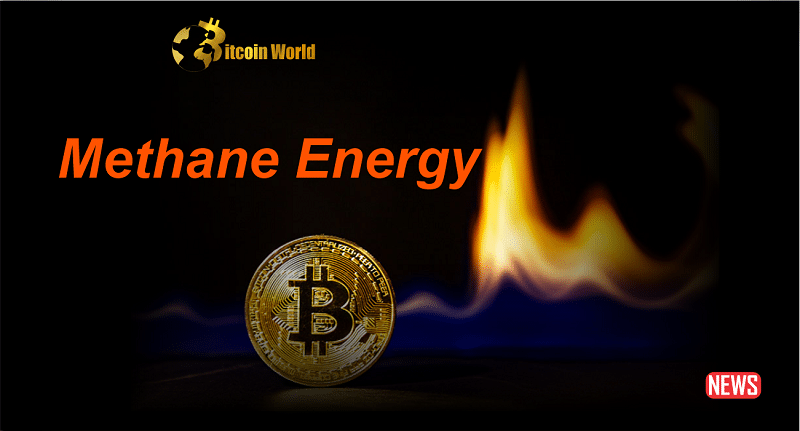Imagine a world where a potent greenhouse gas, often burned off as waste, powers the very network behind Bitcoin. Sounds like a paradox, right? But the World Economic Forum (WEF) is shining a spotlight on exactly that, and it’s got the crypto world buzzing. Why is an organization typically cautious about cryptocurrency suddenly promoting a technology intertwined with it? Let’s dive into this fascinating development.
Why is the WEF Talking About Bitcoin Mining?
The WEF recently released a video showcasing a novel approach to Bitcoin mining, focusing on companies like Crusoe Energy. Instead of directly mentioning Bitcoin, the video refers to these operations as ‘data centers.’ This subtle shift highlights the core technology involved – energy-intensive computing – while sidestepping some of the usual cryptocurrency skepticism. So, what’s the big deal?
Crusoe Energy: Mining Crypto with Waste Gas
At the heart of this story is Crusoe Energy, a company pioneering the use of flared methane to power Bitcoin mining operations. Chase Lochmiller, Crusoe’s CEO and co-founder, explains the process:
- The Problem: Oil fields and landfills often produce natural gas as a byproduct. This gas, primarily methane, is frequently flared – burned off – releasing carbon dioxide and other pollutants into the atmosphere.
- The Solution: Crusoe captures this waste gas and uses it to generate electricity on-site. This electricity then powers their modular data centers, which are specifically designed for energy-intensive tasks like Bitcoin mining.

The Environmental Angle: Turning a Liability into an Asset
The environmental implications here are significant. The WEF emphasizes that methane is a far more potent greenhouse gas than carbon dioxide in the short term. By capturing and utilizing this gas, Crusoe aims to:
- Reduce Methane Emissions: Preventing the direct release of methane into the atmosphere.
- Lower Carbon Footprint: Generating electricity from a source that would otherwise be wasted.
- Enable Low-Cost Computing: Accessing a readily available energy source can drive down the operational costs of data centers.
As Lochmiller stated in the WEF film, this approach offers a double win: reducing emissions and creating cost-effective computing infrastructure.
Data Centers: The Growing Energy Appetite
The WEF also points out the rapidly increasing energy demands of data centers globally. Current estimates suggest that data centers could consume a staggering 8% of the world’s electricity by 2030, a significant jump from the current 1-1.5%. This highlights the urgency in finding sustainable energy solutions for these power-hungry facilities.
Is This the Future of Sustainable Bitcoin Mining?
The involvement of the WEF lends credibility to this innovative approach. Crusoe Energy’s inclusion in the WEF’s ‘Innovator Communities’ further underscores the potential of this technology. However, several questions remain:
- Scalability: Can this model be widely adopted across various oil fields and landfills globally?
- Efficiency: How does the efficiency of energy generation from flared gas compare to other renewable sources?
- Public Perception: Will the association with Bitcoin mining hinder the broader acceptance of this emission-reduction technology?
The US Connection: A Bipartisan Interest?
Interestingly, the concept of using flared gas as an energy source isn’t new. Even before the WEF’s recent interest, figures like Republican Senator Ted Cruz have advocated for it, particularly in energy-rich states like Texas, a major hub for Bitcoin mining. Cruz highlighted the opportunity to utilize energy that was previously being wasted.
Renewable Energy in Bitcoin Mining: A Growing Trend
While flared gas presents a unique solution, it’s important to note the broader trend of increasing renewable energy usage in Bitcoin mining. Recent data suggests that over 50% of Bitcoin mining is already powered by sustainable or renewable energy sources. Reports indicate this figure is even higher, with some estimating over 52% sustainable energy usage. Furthermore, the energy intensity of Bitcoin mining emissions has been decreasing, signaling a positive shift towards more environmentally friendly practices.
Key Takeaways:
- Innovative Solution: Flared methane Bitcoin mining offers a way to reduce potent greenhouse gas emissions while powering energy-intensive computing.
- WEF Support: The World Economic Forum’s promotion signals a growing recognition of this technology’s potential.
- Environmental Benefits: Capturing and utilizing waste gas reduces methane emissions and the need for new energy generation.
- Economic Advantages: Access to stranded energy sources can lower the cost of computing infrastructure.
- Growing Trend: The broader Bitcoin mining industry is increasingly adopting renewable energy sources.
Looking Ahead
The WEF’s focus on gas flare-powered Bitcoin mining marks a significant moment. It highlights the potential for innovative solutions to address both environmental concerns and the energy demands of the digital age. While challenges remain, the prospect of turning a harmful waste product into a valuable energy source for cryptocurrency and other energy-intensive applications is certainly compelling. As technology evolves, expect to see more creative approaches emerge at the intersection of energy, environment, and the digital economy. Will this be a game-changer for sustainable Bitcoin mining? Only time will tell, but the spotlight is now firmly on this intriguing intersection of technology and environmental responsibility.
Disclaimer: The information provided is not trading advice, Bitcoinworld.co.in holds no liability for any investments made based on the information provided on this page. We strongly recommend independent research and/or consultation with a qualified professional before making any investment decisions.


